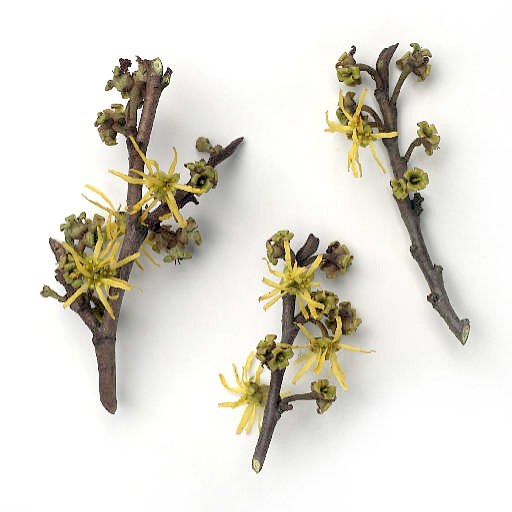Witch Hazel
for your information...

The scientific name of Witch Hazel is Hamamelis virginiana, grown in eastern North America. It's a shrub that grows oval-shaped leaves with yellow flowers. These flowers usually bloom in late autumn or early winter. Generally, however, only the bark, leaves and twigs are used medicinally.
The "witch" in the name Witch Hazel comes from the Anglo-Saxon word meaning "to bend." The name Witch Hazel is also derived from the Old English word for "pliant", and as a matter of fact, the limber branches were used to make archery bows. Other names for Witch Hazel are Snapping Hazelnut and Winter bloom.
Generally speaking, Witch Hazel acts as an astringent with healing properties that relieves itching. It is very useful in skin care. It reduces swelling and inflammation from bruises, hemorrhoids and even helps to relieve varicose veins as well. Witch Hazel is also effective in stopping bleeding both internally and externally.
For hundreds of years, forked twigs from Witch Hazel trees were used as divining rods to locate water and minerals. The Indians drank Witch Hazel tea as a general tonic and used it as a gargle for mouth and throat irritations.
Witch Hazel can be taken in a liquid extract form as well as a powdered form. The liquid form is taken from the leaves or bark of the plant and mixed with water and alcohol. The tea or fluid extract is one of nature's best remedies for stopping excessive menstruation, hemorrhages from the lungs, stomach, nose, uterus, kidneys and rectum. There are several different uses for both the liquid and powdered form of this herb.
Bodily Influences of Witch Hazel: Anti-Inflammatory, antiseptic, astringent, haemostatic, sedative, styptic, tonic.
- Good for wounds or sores, sore and inflamed eyes, There is not an inflamed condition internally or externally that will not benefit by this herb.
- It's a safe, non-toxic herbal substance that can be used in the cleansing and toning of the skin and to help prevent an oily build-up on the tissues of the skin.
- A basic usefulness of Witch Hazel leaves is for treating female congestive conditions of the uterus, cervix and vagina, including vaginitis and prolapsus.
- Witch Hazel steam baths are very beneficial in helping to loosening heavy phlegm and coughing it up.
- It has a slight sedative property when taken internally. It is very useful for treating inflamed or irritated sensitive tissues, like mucous membranes.
- Witch Hazel compresses are used to treat headaches, inflamed eyes, skin irritations, insect bites, burns and infections.
- An extract helps when applied to strained muscles and arthritic joints.
- Witch Hazel is used in great quantities for external use, such as an astringent skin cleanser, body lotion, aftershave, massage liquid for body and scalp, and an aid in setting hair.
- The herbal extract of Witch Hazel is also used for insect bites and sunburns.
General Uses For Witch Hazel At A Glance:
- Abrasions
- Backaches
- Bleeding gums
- Bruises
- Burns
- Cancer
- Circulation
- Colds
- Coughs
- Cuts
- Diarrhea
- Hemorrhoids
- Inflamed eyes
- Fevers
- Gargle
- Gums
- Mouthwash
- Muscles (sore)
- Nervousness
- Nose bleeds
- Poison ivy
- Sinus
- Sore throat
- Stings
- Swellings
- Ulcers
- Vaginitis
- Varicose veins
- Venereal disease
Phytochemical Content: (Plant derived chemical compounds…in other words, these are what the herb plant is made up of.)
Beta-ionone, gallic acid, isoquercitrin, kaempferol, leucodelphinidin, myrcetin, phenol, quercetin, cuercetrin, saponins, & tannins.
Sources of Information:
- Balch, James F., M.D. and Balch, Phyllis A., CNC. Prescription for Nutritional Healing. Penguin Putnam Inc., 2000
- Ritchason, Jack N.D. The Little Herb Encyclopedia. Woodland Publishing Inc., 1995.
- Kloss, Jethro. Back to Eden. Beneficial Books, 1972.

